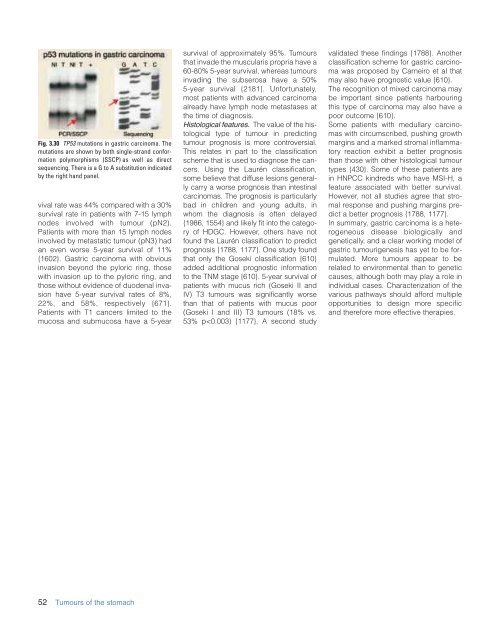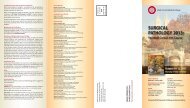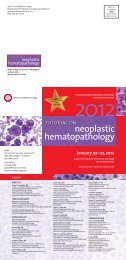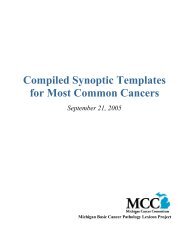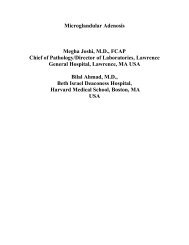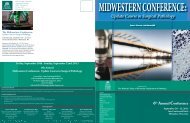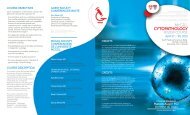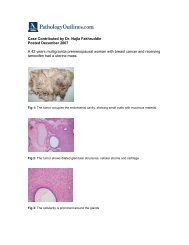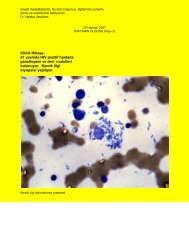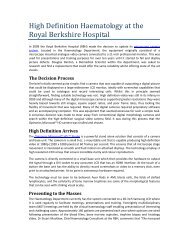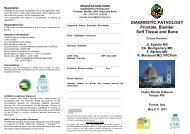CHAPTER 3 Tumours of the Stomach - Pathology Outlines
CHAPTER 3 Tumours of the Stomach - Pathology Outlines
CHAPTER 3 Tumours of the Stomach - Pathology Outlines
Create successful ePaper yourself
Turn your PDF publications into a flip-book with our unique Google optimized e-Paper software.
Fig. 3.30 TP53 mutations in gastric carcinoma. The<br />
mutations are shown by both single-strand conformation<br />
polymorphisms (SSCP) as well as direct<br />
sequencing. There is a G to A substitution indicated<br />
by <strong>the</strong> right hand panel.<br />
vival rate was 44% compared with a 30%<br />
survival rate in patients with 7-15 lymph<br />
nodes involved with tumour (pN2).<br />
Patients with more than 15 lymph nodes<br />
involved by metastatic tumour (pN3) had<br />
an even worse 5-year survival <strong>of</strong> 11%<br />
{1602}. Gastric carcinoma with obvious<br />
invasion beyond <strong>the</strong> pyloric ring, those<br />
with invasion up to <strong>the</strong> pyloric ring, and<br />
those without evidence <strong>of</strong> duodenal invasion<br />
have 5-year survival rates <strong>of</strong> 8%,<br />
22%, and 58%, respectively {671}.<br />
Patients with T1 cancers limited to <strong>the</strong><br />
mucosa and submucosa have a 5-year<br />
survival <strong>of</strong> approximately 95%. <strong>Tumours</strong><br />
that invade <strong>the</strong> muscularis propria have a<br />
60-80% 5-year survival, whereas tumours<br />
invading <strong>the</strong> subserosa have a 50%<br />
5-year survival {2181}. Unfortunately,<br />
most patients with advanced carcinoma<br />
already have lymph node metastases at<br />
<strong>the</strong> time <strong>of</strong> diagnosis.<br />
Histological features. The value <strong>of</strong> <strong>the</strong> histological<br />
type <strong>of</strong> tumour in predicting<br />
tumour prognosis is more controversial.<br />
This relates in part to <strong>the</strong> classification<br />
scheme that is used to diagnose <strong>the</strong> cancers.<br />
Using <strong>the</strong> Laurén classification,<br />
some believe that diffuse lesions generally<br />
carry a worse prognosis than intestinal<br />
carcinomas. The prognosis is particularly<br />
bad in children and young adults, in<br />
whom <strong>the</strong> diagnosis is <strong>of</strong>ten delayed<br />
{1986, 1554} and likely fit into <strong>the</strong> category<br />
<strong>of</strong> HDGC. However, o<strong>the</strong>rs have not<br />
found <strong>the</strong> Laurén classification to predict<br />
prognosis {1788, 1177}. One study found<br />
that only <strong>the</strong> Goseki classification {610}<br />
added additional prognostic information<br />
to <strong>the</strong> TNM stage {610}. 5-year survival <strong>of</strong><br />
patients with mucus rich (Goseki II and<br />
IV) T3 tumours was significantly worse<br />
than that <strong>of</strong> patients with mucus poor<br />
(Goseki I and III) T3 tumours (18% vs.<br />
53% p


